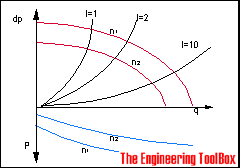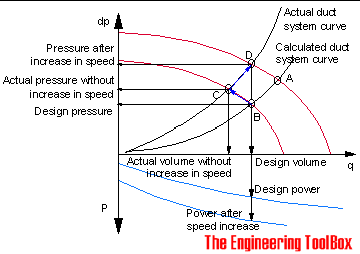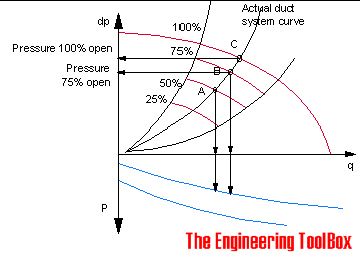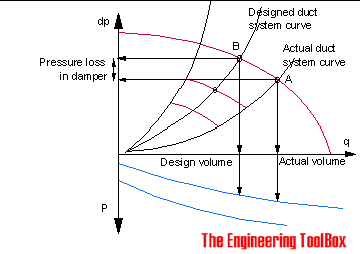Fans - Capacity Control
How to modulate fans and their capacities.
It is common to present the pressure head of a fan as a function of air volume in a capacity diagram as

The red lines indicates pressure head related to air volume. The lines are for different speeds. The black lines marked "l" are the duct curves (or throttle lines). The blue lines indicates the power consumption of the fan.
The fan capacity can be modulated by
- modulating the speed
- using inlet vanes dampers
- adjusting wheel blades
- throttling the air volume with a damper
Modulating the Fan Speed
The capacity can be controlled as indicated in the capacity diagram:

- The calculated duct curve (or system curve) crosses the capacity line in point B. The design volume, pressure and power are as indicated
- The actual duct curve crosses the capacity line in point C. With the actual duct curve the air volume is reduced, the pressure head is increased and the power reduced
- To achieve the designed volume the speed are increased until the actual system duct curve crosses the capacity line in D. The pressure and power are increased as indicated
The speed of a fan can be modulated by a using a frequency controller on the electric motor supply - or by changing the configuration of the fan and/or the motor disc drive. A frequency controller is flexible and can be modulated continuously from the control system.
Belt Gearing
Belt gearing is normally fixed and can be calculated as
dfan nfan = dbeltdisc nbeltdisc (1)
where
d = diameter
n = speed
Inlet Vane Dampers
If an inlet vane damper is properly installed it provides an inlet swirl in the direction of the fan rotation. This will reduce the power consumption of a fan as indicated below:

- The fan is designed for the calculated duct system curve with 75% opening of the inlet vane at point B
- The fan can be modulated upward (B to C) on downward (B to A) by opening or closing the inlet vane. Pressures, volumes and powers are indicated
The power consumption will not be reduced as much as with speed modulation.
Adjusting Blades
Adjusting blades is possible on some axial and propeller fans.
This will reduce the fans power consumption but not as much as modulating the speed.
Throttling
Throttling the fan with a discharge damper will reduce the air flow volume, but the systems pressure loss will be increased.

- The fan is designed for the designed duct system curve point B
- The actual curve crosses the capacity line in A. Throttling the fan moves the actual duct system curve to the designed system curve
- The power is decreased but energy is loosed in the damper. The total efficiency is reduced
The power consumption will still be high, the fan efficiency low, and the method should in general be avoided.



